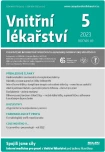Implications of highly suppressive treatment HIV infection
Authors:
Svatava Snopková; Petr Husa
Authors‘ workplace:
Klinika infekčních chorob FN Brno a LF MU Brno
Published in:
Vnitř Lék 2023; 69(5): 289-292
Category:
doi:
https://doi.org/10.36290/vnl.2023.057
Overview
Treatment of HIV infection has modified the initially fatal infection into a typically chronic disease requiring lifelong treatment. However, there is no complete normalization of immune activation, signs of inflammation and prothrombotic state in treated patients. This condition is the result of many factors, but the main cause is thought to be the residual production of HIV-1 RNA and viral proteins by infected cells in cellular reservoirs. Persistence of immune activation/inflammation/prothrombotic state leads to the pathophysiology of „sterile inflammation“ and so-called non-AIDS diseases, which manifest one to two decades earlier in those infected. Despite all the pitfalls and unwanted secondary manifestations of antiretroviral drugs, the treatment of HIV infection has managed to reverse the trajectory of a fatal pandemic and has made it possible to approach therapeutic modalities that were absolutely unimaginable just a few years ago. Solid organ transplantation is now a completely legitimate therapeutic method for patients living with HIV, and highly suppressive treatment even allows transplantation from an HIV-infected donor. The text below presents a brief overview of the basic pitfalls, but also of the successes, of the current highly suppressive treatment of HIV infection.
Keywords:
HIV – Transplantation – Antiretroviral therapy – HIV reservoir – immune activacion – non-AIDS diseases
Sources
- Dominick L, Midgley N, Swart LM, et al. HIV-related cardiovascular diseases: the search for a unifying hypothesis. Am J Physiol Heart Circ Physiol. 2020;318: H731-H746.
- Perkins MV, Joseph SB, Dittmer DP, et al. Cardiovascular disease and thrombosis in HIV infection. Arterioscler Thromb Vasc Biol. 2023;43:175-191.
- Srinivasa S, Thomas TS, Feldpausch MN, et al. Coronary vasculature and myocardial structure in HIV: physiologic insights from the renin–angiotensin–aldosterone system. J Clin Endocrinol Metab. 2021;106(12):3398–3412.
- Teer E, Dominick L, Mukonowenzou NC, et al. HIV-related myocardial fibrosis: inflammatory hypothesis and crucial role of immune cells dysregulation. Cells. 2022;11:2825. Available from: https://doi.org/10.3390/cells11182825.
- McCutcheon K, Manga P. Human immunodeficiency virus and cardiovascular disease: revisiting the inflammation–thrombosis axis. Thromb Haemost. 2022;122:476–479.
- Lee D. HIV: how to manage dyslipidaemia in HIV. Drugs Context. 2022;11:2021-8-7. Available from: https://doi.org/10.7573/dic.2021-8-7.
- Van Welzen BJ, Oomen PG, Hoepelman AI. Dual antiretroviral therapy – all quiet beneath the surface? Front Immunol. 2021;12:637910. Available from: https://www.ncbi.nlm. nih.gov/pmc/articles/PMC7906996/.
- Navarrete-Muñoz MA, Restrepo C, Benito JM, et al. Elite controllers: a heterogeneous group of HIV-infected patients. Virulence. 2020;11(1):889-897.
- Ait-Ammar A, Kula A, Darcis G, et al. Current status of latency reversing agents facing the heterogenity of HIV-1 cellular and tissue reservoirs. Front Microbiol. 2020;10:3060. Available from: https://www.ncbi.nlm.nih.gov/pmc/articles/PMC6993040/.
- Lushniak SA, Durand CM. Donors with human immunodeficiency virus and hepatitis C virus for solid organ transplantation: what’s new. Curr Opin Infect, DiS. 2022;35(4):321-329.
- Ademowo OS, Dias HK, Burton DG, et al. Lipid (per) oxidation in mitochondria: an emerging target in the ageing process? Biogerontology. 2017;18(6):859-879.
- Steven S, Frenis K, Oelze M, et al. Vascular inflammation and oxidative stress: major triggers for cardiovascular disease. Oxid Med Cell Longev. 2019;2019(7092151):26. Available from: https://doi.org/10.1155/2019/7092151.
- Montero N, Moreso F, Cruzado JM. HIV-positive deceased donor–to–HIV-positive recipient kidney transplantation: The HOPE must go on. Am J Transplant. 2021;21(5):1683-1684.
- Werbel WA, Durand CM. Solid organ transplantation in HIV-infected recipients: history, progress, and frontiers. Curr HIV/AIDS Rep. 2019;16(3):191–203.
- Durand CM, Zhang W, Brown DM, et al. A prospective multicenter pilot study of HIV-positive deceased donor to HIV-positive recipient kidney transplantation: HOPE in action. Am J Transplant. 2021;21(5):1754-1764.
- Kolber, Michael A. HIV solid organ transplantation looking beyond HOPE. AIDS. 2018;32(13):1733-1736.
- Botha J, Fabian J, Etheredge H, et al. HIV and solid organ transplantation: where are we now. Curr HIV/AIDS Rep. 2019;16(5):404-413.
- Durand CM, Florman S, Motter JD, et al. HOPE in action: a prospective multicenter pilot study of liver transplantation from donors with HIV to recipients with HIV. Am J Transplant. 2022;22(3):853-864.
- Lushniak S, Durand CM. Donors with human immunodeficiency virus and hepatitis C virus for solid organ transplantation: what’s new. Curr Opin Infect, DiS. 2022;35(4):321-329.
- Klitenic SB, Levan ML, Van Pilsum Rasmussen SE. et al. Science over stigma: lessons and future direction of HIV-to-HIV transplantation. Curr Transpl Rep. 2021;8:314-323.
- Botha J, Conradie F, Etheredge H, et al. Living donor liver transplant from an HIV-positive mother to her HIV-negative child opening up new therapeutic options. AIDS. 2028;32(16):F13-F19.
- Nel JS, Conradie F, Botha J, et al. Southern African HIV Clinicians Society guidelines for solid organ transplantation in human immunodeficiency virus: An evidence-based framework for human immunodeficiency virus-positive donors and recipients. South Afr J HIV Med. 2020;21(1):1133. Available from: https://pubmed.ncbi.nlm. nih.gov/33240537/.
- Benner SE, Eby Y, Zhu X, et al. The effect of induction immunosuppression for kidney transplant on the latent HIV reservoir. JCI Insight. 2022;7(21):e162968. Available from: https://www.ncbi.nlm.nih.gov/pmc/articles/PMC9675561/.
Labels
Diabetology Endocrinology Internal medicineArticle was published in
Internal Medicine

2023 Issue 5
Most read in this issue
- Acute kidney injury in patients with cirrhosis – practical summary
- Dyslipidemia – the known unknown
- News in respiratory medicine
- Cardiovascular disease and kidney transplantation
